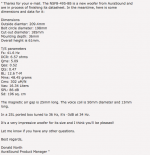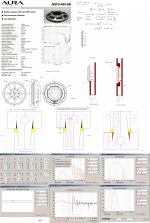I'm looking for a bass driver for use in a shallow enclosure. It will form the woofer/s for a pair of satellite speakers which are being run as bedroom system.
The satellites run to 150Hz or so and the woofer enclosure will take over from there. The whole system is wall-mounted. I appreciate that 150Hz is a little high for a sub system but that won't be critical for the intended use.
The woofer enclosure will hang on the wall between the two satellites so I'd like them to match in terms of depth. Here is a brief spec of what I'm looking for:
Extension - down to 50Hz
Sensitivity - not critical as the unit will have it's own amplifier
Size - diameter not critical as the system will be run at relatively low level. Average listening levels in room, 2-meteres from the satellites is around 65-70 dB, peaks at 80dB.
Enclosure - I'm thinking closed box. There is 20-30 litres available.
Depth of drive unit - the tricky bit - 2 inches (50mm) from front of chassis to back of magnet.
I would be happy to use a number of smaller drivers to get there if a single driver is not available. Given the output and extension, the diameter of a single unit doesn't have to be too great - around 5 to 8" would be ideal.
I've had a look around but not found anything so far, so I'm opening it up here to see if anyone has found something similar. My next step will be to have a look at some of the available car drivers but I don't require the extreme xmax some of those go in for.
Thanks for any input.
The satellites run to 150Hz or so and the woofer enclosure will take over from there. The whole system is wall-mounted. I appreciate that 150Hz is a little high for a sub system but that won't be critical for the intended use.
The woofer enclosure will hang on the wall between the two satellites so I'd like them to match in terms of depth. Here is a brief spec of what I'm looking for:
Extension - down to 50Hz
Sensitivity - not critical as the unit will have it's own amplifier
Size - diameter not critical as the system will be run at relatively low level. Average listening levels in room, 2-meteres from the satellites is around 65-70 dB, peaks at 80dB.
Enclosure - I'm thinking closed box. There is 20-30 litres available.
Depth of drive unit - the tricky bit - 2 inches (50mm) from front of chassis to back of magnet.
I would be happy to use a number of smaller drivers to get there if a single driver is not available. Given the output and extension, the diameter of a single unit doesn't have to be too great - around 5 to 8" would be ideal.
I've had a look around but not found anything so far, so I'm opening it up here to see if anyone has found something similar. My next step will be to have a look at some of the available car drivers but I don't require the extreme xmax some of those go in for.
Thanks for any input.
The Mivoc 16 Ω drivers at Strassacker: Lautsprecher - Boxen - Selbstbau are very interesting 
There seem to be plenty of options at 2.25"-2.5", but at 2" the players thin out to few, if any that fit the rest of your needs.Depth of drive unit - the tricky bit - 2 inches (50mm) from front of chassis to back of magnet.
Thanks for any input.
Standard 2 x 4" construction leaves 3.5" depth, why a 2" limit?
The limit on depth is set by the satellite speakers either side - they're 3" deep. I'd prefer to try and keep the bass box the same depth to minimise reflections.
Hence not aiming too low into LF. I realise it won't be possible.
If there is anything in the 2.5" range, I'll take a look at those.
Hence not aiming too low into LF. I realise it won't be possible.
If there is anything in the 2.5" range, I'll take a look at those.
Dissi's suggestion looks good, at 61mm "overall height" looks to fit.If there is anything in the 2.5" range, I'll take a look at those.
Attachments
I'll leave the others to help you with the woofer but you might want to have a look here if you are considering wall mount:
http://www.diyaudio.com/forums/full...k-building-cornu-spiral-horn-now-you-can.html
Highly rewarding project and you can decide later if you need a woofer.
http://www.diyaudio.com/forums/full...k-building-cornu-spiral-horn-now-you-can.html
Highly rewarding project and you can decide later if you need a woofer.
Even if you can find a bass unit that will fit into a shallow depth, there should at least be enough space for damping material on the rear wall. Otherwise, assuming a paper cone, the rear wave is reflected off the rear wall and through the cone. Even if the cone is of a material that won't allow sound to pass through it, I would still think the cone very close to the rear wall would cause problems.
Regards,
Pete
Regards,
Pete
Yes, that is one of the first considerations to be done. That's why I suggested little
stiff cones which have more impact, i.e. find less air resistance . I was thinking of some side ( of the box ) mounting or inclined respect to the wall . Side mounting, one each side and one with the magnet in sight, in BR with slotted port ( heavily EQ'ed ). Adding some mass to the cone might help in lowering Fs ( and efficiency )
stiff cones which have more impact, i.e. find less air resistance . I was thinking of some side ( of the box ) mounting or inclined respect to the wall . Side mounting, one each side and one with the magnet in sight, in BR with slotted port ( heavily EQ'ed ). Adding some mass to the cone might help in lowering Fs ( and efficiency )
Even if the cone is of a material that won't allow sound to pass through it, I would still think the cone very close to the rear wall would cause problems.
Regards,
Pete
There is a cone material which does not allow sound to pass through it?
There is a cone material which does not allow sound to pass through it?
Polypropylene? That is a kind of plastic resin. I really don't know for sure, but I would think that plastic is relatively much more impervious to sound passing thru it. Strangely enough, it seems that all materials can transmit some sound energy.
-Pete
Last edited:
Pete,Even if you can find a bass unit that will fit into a shallow depth, there should at least be enough space for damping material on the rear wall. Otherwise, assuming a paper cone, the rear wave is reflected off the rear wall and through the cone. Even if the cone is of a material that won't allow sound to pass through it, I would still think the cone very close to the rear wall would cause problems.
Regards,
Pete
The OP stated in the OP "The satellites run to 150Hz or so and the woofer enclosure will take over from there."
The wavelength of 150 Hz is 7.5 feet long, "damping material " on the rear wall will have virtually no effect in reflected waves at that low of frequency.
Pete,
The OP stated in the OP "The satellites run to 150Hz or so and the woofer enclosure will take over from there."
The wavelength of 150 Hz is 7.5 feet long, "damping material " on the rear wall will have virtually no effect in reflected waves at that low of frequency.
Good point. So that means the wave reflected off of the rear wall is very close to 180 degrees out of phase with the sound radiated into free air. Then also there is some cancellation as a result of that that nothing can be done about. Would you agree?
The author of the book that I am referring to about this subject of the wave reflected off the rear wall speaks of the reflected wave passing "right through" the cone. The cone he says is "virtually acoustically transparent". But I think a more correct description would be that the reflected wave (inside the box, off the rear wall) is exerting a force on the cone in opposition to the driven direction. In that way, the reflected wave might be said to in a way to travel "through" the cone.
-Pete
- Status
- This old topic is closed. If you want to reopen this topic, contact a moderator using the "Report Post" button.
- Home
- Loudspeakers
- Multi-Way
- Bass unit for shallow enclosure

 Wall-sub:
Wall-sub: